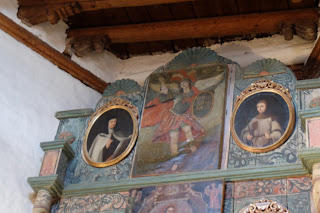 |
| San Miguel Mission, Santa Fe, NM |
First built in 1598 as a tiny hermita by the central Mexican Tlaxcalan Indians who accompanied Don Juan Oñate as workers on his settlement of the New Mexican territory, it was rebuilt by the Franciscan Friars, who were a part of the Spanish settlement, into a church in 1610. During the Pueblo Revolt in 1680, which drove the Spanish out of the area, the church was burned. Tragically, the Tlaxcalans had gone into the church for refuge and were burned to death when the attacking Pueblos shot flaming arrows into the church, setting it on fire and killing all 80 who had sought shelter within.
The Spanish returned to Santa Fe twelve years later and in 1710 San Miguel Mission was restored and used as a military chapel but fell into disuse when a new military chapel which eventually was the site for today's St. Francis Cathedral was built on the town's plaza.
In 1798 the building was restored by the Mayor of Santa Fe and the altar screen that exists to this day was installed.
 |
| Altar Screen, San Miguel Mission, Santa Fe NM |
Sometime around 1830 a triple-tiered bell-tower was added to the church and in 1872 during a severe storm that was followed by a rare 4.5 earthquake, the bell-tower toppled. The bell which was made in Spain in 1356 survived the fall and is displayed in the church where it can be rung by visitors.
 |
| San Jose Bell, San Miguel Mission, Santa Fe NM |
Apart from its historical significance, San Miguel Mission is a virtual museum of Spanish Colonial religious art. To return to the altar screen or reredos, it is one of the oldest in New Mexico and was created by artists of historical significance.
 |
| Altarpiece, San Miguel Mission, Santa Fe NM |
 |
| San Miguel (top center), by Bernardo Miera y Pachecho |
The statue of San Miguel in the middle of the altar was carved in Mexico and brought to Santa Fe by the Franciscan Friars.
 |
| Statue of St. Michael the Archangel, San Miguel Mission, Santa Fe NM |
The very earliest form of religious art in New Mexico were animal hides paintings used by the Franciscan friars in the evangelization of the Pueblo peoples. These paintings are fairly rare to day because the fragile hides did not survive the years, but San Miguel has two beautiful specimens. The Passion of Christ is painted on buffalo hide and the other, St. John the Baptist, was painted on deer-skin. Paintings such as these were rolled-up and carried around by the friars to teach the would-be converts about the new religion.
 |
| The Passion of Christ, San Miguel Mission, Santa Fe NM |
 |
| Rear of Church, San Miguel Mission, Santa Fe NM |
The original 16th century church has been uncovered during excavations and is visible within the church. Reports claim that ghosts from the San Miguel's previous incarnations visit the premises from time to time. These include a group of six Indians who emerge from a side hall and walk to the front of the chapel and young children running up and down the aisle. The church guide with whom I spoke said that while he has never seen any of these specters, he has heard unusual noises.
 |
| Steps to Sanctuary of 1610 Church, San Miguel Mission, Santa Fe NM |
 |
| Part of Altar of 1610 church, San Miguel Mission, Santa Fe NM |

No comments:
Post a Comment